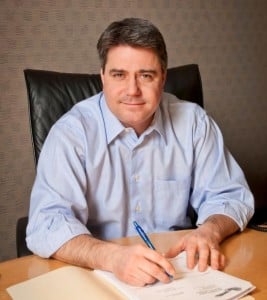
Philadelphia City Councilman Bobby Henon
As readers of this blog and our newsletter are well aware, the Bicycle Coalition of Greater Philadelphia has spent the last few years advocating for physically-protected bike lanes on Philadelphia’s streets. We’ve been in talks with several city agencies and city officials about installing such safe infrastructure for Philly’s cyclists.
Councilman Bobby Henon, of Philadelphia’s 6th District, has been adamant about working to get protected bike lanes in his district. We’ve held several meetings with him and the Streets Department over the past few months to consider several candidate roads.
And now it’s official: the Streets Department has committed to designing Philadelphia’s first protected lanes for installation in Henon’s district. After working with the Philadelphia Streets Department and the Bicycle Coalition of Greater Philadelphia, Henon has set into motion a process that will assure his constituents a safer bicycle commute. We hope more Council members will follow his lead.
In the recently-unveiled 2015 Bicycle Infrastructure project map, the Streets Dept. details the 67 miles of new or enhanced bicycle infrastructure around Philadelphia, which includes Philadelphia’s first protected lanes on Frankford and Ryan Avenues in Northeast Philadelphia.

A screenshot from the Streets Department’s bike facilities map
The Ryan Ave. protected lane is along Pennypack Park and will help make the ride safer for those students who commute by bicycle to both Austin Meehan Middle School and Abraham Lincoln High School, both located along the street. It is also part of the scenic Mayfair walking and biking loop that borders the School District of Philadelphia property and Pennypack.
Similarly, the Frankford Ave. lane, though small, creates a safer and seamless road crossing for the Pennypack Trail [is a good connection from the avenue into Pennypack Park, and especially onto the Pennypack Trail in Northeast Philly]. Currently trail users ride on the sidewalk or against vehicular traffic on Frankford.
“While Philadelphia continues to embrace the bike sharing system, it’s just as important that we find ways to give cyclists a safe way to ride,” Henon told the Bicycle Coalition after the Streets Dept. list was released. “Protected bike lanes are essential for providing that sense of safety, bringing more riders into the fold. I was proud to support protected lanes in my district and hope to see their continued growth citywide.”

Current streetview of Ryan Ave. in Northeast Philadelphia
Making an effort for protected lanes shows that Henon is genuinely concerned about his constituents’ safety, and wants more of them to feel comfortable on bikes. The project also demonstrates that the Streets Department is committed to safety and implementing innovative bicycle infrastructure.
There’s plenty of information on how protected lanes both keep cyclists safer and ease the nerves of potential cyclists who understandably don’t want to have to ride alongside traffic. A People For Bikes post sums up protected lanes effectiveness very well:
1) Why better lanes matter: Academic research shows that the many people who would like to bike more, but don’t, are particularly concerned about safety. Protected lanes create the sense of “subjective safety” that helps change that behavior.
2) 14 ways to make bike lanes better: We made an infographic with photos of the most popular ways of separating bikes and cars. It briefly explores the costs and advantages of each.
3) Recent history: “The Rise of the North American Protected Bike Lane” is a 2013 Momentum magazine cover story with an excellent account of how this idea returned to North America and began to spread.
4) What to call them: Cycle tracks? Separated bike lanes? Green lanes? We did empirical research to figure out the best language for these facilities and settled on “protected bike lane.” (We also have a complete style guide, including the precise definition of a protected lane.)
5) The Danish model: We talk about Copenhagen a lot, and lead study tours there, because it’s a mid-size city (about the size of Columbus, Ohio) that was quite auto-oriented in the early 1960s but successfully reversed course with the help of protected lanes.
And perhaps even moreso, as the city sees the success of Frankford and Ryan Avenues, more councilpeople will inevitably step up (as they have in other cities) and want to keep their own constituents safe.
Want to thank Bobby Henon for fighting for safety and getting the protected bike lane process started? Send him an email.

